Entrevista com Masami Kurumada no Artbook dos 50 anos da WSJ
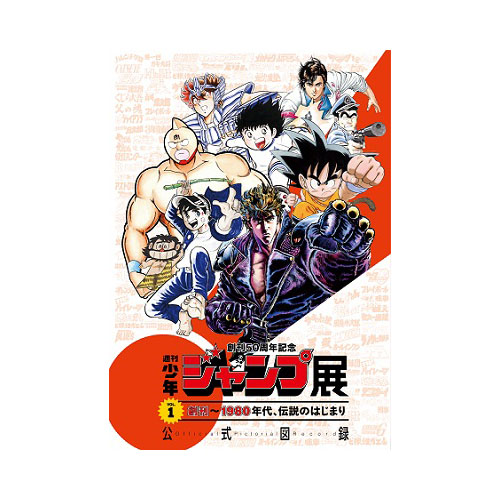
Previamente publicada de forma reduzida na edição nº 35 da revista Weekly Shonen Jump (publicada em julho de 2017), a versão completa da entrevista com Masami Kurumada foi publicada no “Sokan 50 shunenkinen Shukan Shonen Jump-ten VOL. 1 Sokan ~ 1980-nendai, Densetsu no Hajimari Koshiki Zuroku” (Catálogo/Livro Ilustrado Oficial da Exposição de 50 anos da Weekly Shonen Jump – volume 1, do lançamento à década de 1980, o começo da lenda”), ou seja, o artbook oficial do evento. O livro foi vendido no final do mês de agosto de 2017, no decorrer do evento ocorrido em Tóquio (mais detalhes aqui).
O livro traz uma série de entrevistas com os mangaka das obras envolvidas e todo o conteúdo do livro está em japonês e inglês. A tradução acima foi feita levando em consideração, primeiramente, minha própria versão tomando como base o texto original em japonês. O texto em inglês serviu apenas para refletir acerca de alguns breves trechos. No entanto, à título de curiosidade e também para facilitar o entendimento de visitantes de outros idiomas, transcrevi aqui o conteúdo em inglês tal qual encontra-se no livro.
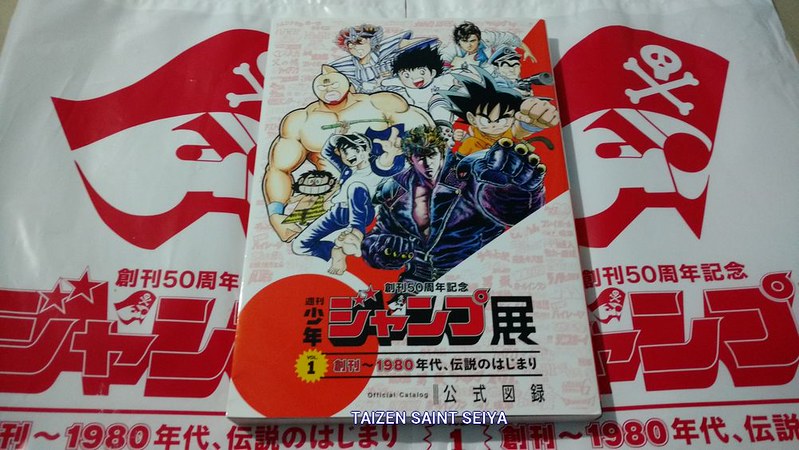
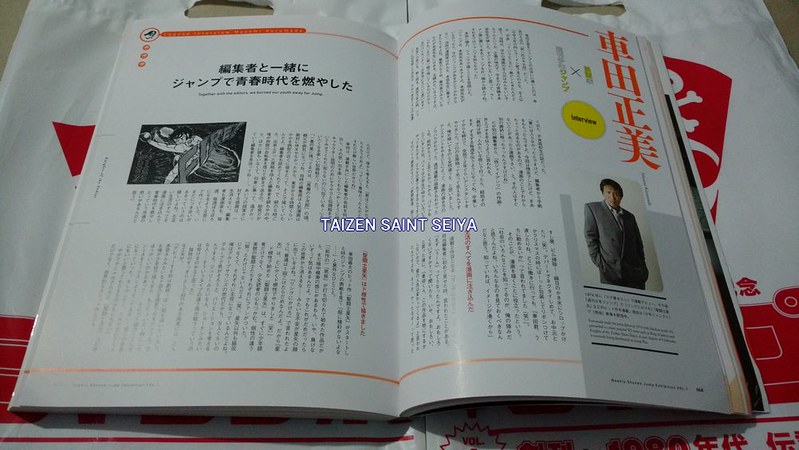
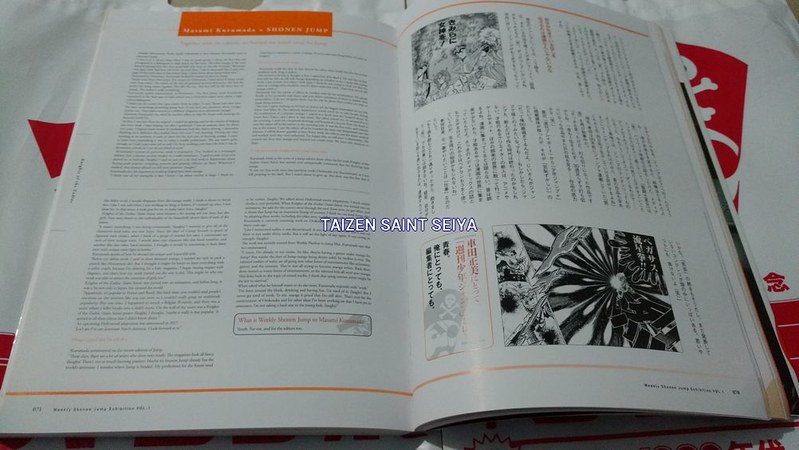
MASAMI KURUMADA X SHONEN JUMP
Kurumada made his series debut in 1974 with Sukeban Arashi.
He proceeded to create a popular WJ series such as Ring Ni Kakero, and Knights of the Zodiac (Saint Seiya).
A new chapter of Otokozaka is currently being distributed on Jump Plus.
Together with the editors, we burned our youth away for Jump.
Hiroshi Motomiya’s Otoko lppiki Gakidaish is how Masami Kurumada came to encounter Jump.
“I saw it at ramen shop when I was in nineth grade. I think the fact that the protagonist is a delinquent is what stuck me the most; The other manga of the time features protagonists that were good kids who were on the side of justice. Motomiya tore apart what had been the norm up until then. was so fascinated that l read every page ot the entire issue at that ramen shop. l didn’t know about Jump before that.”
Fascinated by Motomiya, Kurumada decided he wanted to draw for Jump.
“Jump came from Motomiya. If weren’t for Motomiya, I don’t know if Jump would even exist today. The artists of the day all gathered around Motomiya. He had the power the bring artits together. He’s like the sun. And he’s still on the front lines of manga. His vitality is really something.”
Kurumada speaks passionately of Motomiya. The first Jump work Kurumada submitted in his final year of high school was a Motomiya-esque story about a high school delinquent.
“I didn’t get the award, but I got a letter from an editor. It said, Better luck next time. You have something promising going here. If you have any questions about manga contact me. That editor moved to a different magazine soon afterwards, though.”.
However, Kurumada was asked by another editor to help Ko Inoue with drawing for Samurai GIANTS.
“At first, I was just there for support. I ended up getting used to the routine of helping out every week. I kept helping out after I graduated. I was an assistant there for about two years. Original works drawn by professionals look like they’re shining. During my time working as a assistent, I came to learn the ins and outs of drawing manga. I can to learn how painstaking it was to create a weekly publication. The pay wasn’t quite enough, so I had a part-time job as well. I’ve been working part-time jobs since I was in elementary school, so I can do any kind of work.”
Kurumada’s resume of part-time work is impressive. “I’ve worked as a newspaper delivery boy, a cleaner, an iron worker, in a sushi restaurant… I used to pour syrup over shaved ice at festivals. (laughs) I used to put on a tie and work at department stores during peak seasons, wrapping presents and putting ribbons on them. Whenever I worked, they always offered me full time positions. (laughts)”
Kurumada says his experiences working helped him draw manga.
“I think one of my strengths is that I know a lot about society at larger. I think it’s important to experience a variety of things. If you’ve seen something before, it’s easier to imagine.”
We poured our lives into manga
Kurumada recalls the time he first showed his editor what would become his second serialized work, Ring ni kakero.
“He seemed to be lost in thought at first. I asked him if he liked it. He said that he did. and told me that my life will change depending on whether or not I make this manga work. I was ecstatic, but when I look back, I think he was trying to warn me that my career as a manga artist would be over if I didn’t make this work. That’s how vicious the manga world is.“
Kurumada lists the names of editors he worked with for his serializations. He speaks fondly of his memories with them, and even draws caricatures of them to explain their personalities. (I do not recognize them, but the way he draws them makes me want to laugh along anyway.)
“The time I spent working on FUMA no Kojiro left the biggest impression on me. My father had fallen ill. The editorial department would never let us take breaks during the serialization of a popular manga. I stayed at a hotel near the hospital about six hours from Tokyo, and I drew in that hotel. The editor joined me. Around five in the morning, I took the completed drawings and borrowed a bicycle from the hotel to send the editor off to the station in the morning mist. It was the first train, and nobody was at the station. I saw the editor off as he boarded the train and disappeared into the distance. will be forever grateful to him. Every week, the editors and the artists worked and worked until they were exhausted. I’m happy that we still have a relationship. We poured our lives into manga and burned our youth away. We have this memory share.
It took guts to make Knights of the Zodiac (Saint Seiya).
Kurumada looks at the cover of a Jump edition from when his hit work Knights of The Zodiac (Saint Seiya) first started, and unexpectedly comments that the drawings lack energy.
“It was my first work since [my previous work] Otokozaka was discontinued, so I was still grasping in the dark. But I wasn’t about to give up. But there was this fear that if this didn’t work, I would disappear from the manga world. I think it shows in Seiya’s face. Like I was told when I was working on Ring ni kakero, if I messed up once, I was done for. In that sense, it took guts for me to make Saint Seiya. (laughs)”
Knights of the Zodiac (Saint Seiya) soon became a hit among not just boys, but also girls. Fans were drawn to the individuality of the beautifully drawn faces of each of the Saints.
“It wasn’t something I was doing consciously. (laughs) I wanted to give all of the characters lead roles, not just Seiya. Since the days of Group Sounds [a genre of Japanese rock music], when I think of a group of around five men, I concentrate on each of their unique traits. I would draw one character like this band member, another like this other band member. I thought it would be interesting to have these men with unique traits fight in battles.”
Kurumada speaks of how he devised his unique and impactful style.
“Before my debut work, I used to draw dramatic manga. I wanted my style to pack punch like Motomiyas did. But I thought it might be better to draw everything with a softer touch, because I’m drawing for a kids magazine. I began mixing impact with n elegance, and that’s how my work turned out the way it did. This might be why my work was able to attract the attention of girls, too.”
Knights of the Zodiac (Saint Seiya) was turned into an animation, and before long. it was a hit not only in Japan, but around the world.
“Apparently, it’s popular in France and Brazil. But back then, you couldn’t read people’s reactions on the internet like you can now, so I couldn’t really grasp its worldwide popularity. But one time, I happened to watch a Belgian B-movie, and there was a scene where a killer breaks into a child’s room. On the wall of the room was a Knights of the Zodiac (Saint Seiya) poster. (laughs), I thought, ‘maybe it really is that popular’. It spread to all these places that I didn’t know about.”
An upcoming Hollywood adaptation was announced in 2017.
“Let’s see if it can dominate North America. I look forward to it.”
Manga is proof that I am alive.
Kurumada commented on the recent editions of Jump.
These days, there are a lot of artists who draw very nearly. The magazines look all fancy. (laughs) There’s not as much burning passion. Maybe it’s because Jump already has the world’s attention. I wonder where Jump is headed. My predictions for the future tend to be correct. (laughs) We talked about Hollywood movie adaptations. I think mixed media is very powerful. When Knights of the Zodiac (Saint Seiya) was turned into an animation, the sales for the comics went through the roof. Even now, we get offers, and it shows that Jump has an impressive lineup of content. I think we can keep Jump alive by adapting these works, including the older ones, to different mediums.”
Kurumada is currently resuming work on Otokozaka, which was serialized in thirty years ago.
“Like I mentioned earlier, it was discontinued. It was never number one, and it was cut short in just under thirty weeks. But it will see the light of day again. It was saving its strength. (laughs) “
The work was recently moved from Weekly Playboy to Jump Plus. Kurumada says that he’s embarrassed.
“I mean, I’m already in my sixties. It’s like, they’re having a geezer make manga for Jump? But maybe the days of Jump manga being drawn solely by rookies is over. The talented rookies of today are all going into other forms of entertainment like animation, games, and the internet. They’re not all trying to become manga artists. Back then there weren’t as many forms of entertainment, so the talented kids all went into manga. This links back to the topic of mixed media. I think that using veteran artists might the key to survival.”
When asked what he himself wants to do the most, Kurumada responds with “work”.
“I’ve been around the block, drinking and having fun. I’m tired of it. (laughs) But I never get tired of work. To me, manga is proof that I’m still alive. That’s true for continuation of Otokozaka and for other ideas I’ve been working on that I have yet to announce. I’m not taking a back seat to the young kids. (laughs)”
What is Weekly Shonen Jump to Masami Kurumada?
Youth. For me, and for the editors too.

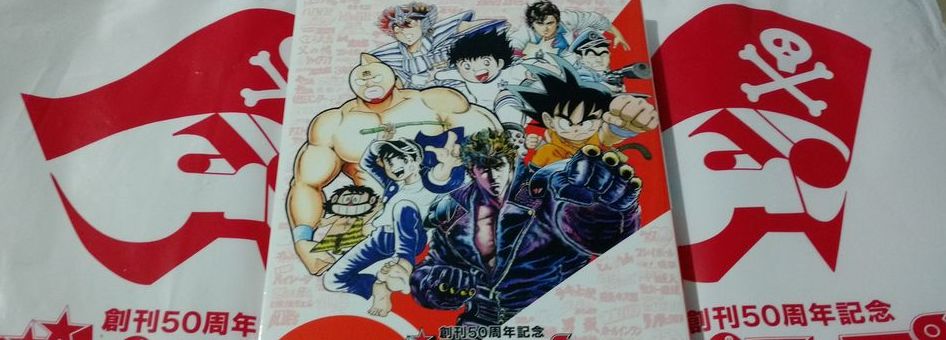
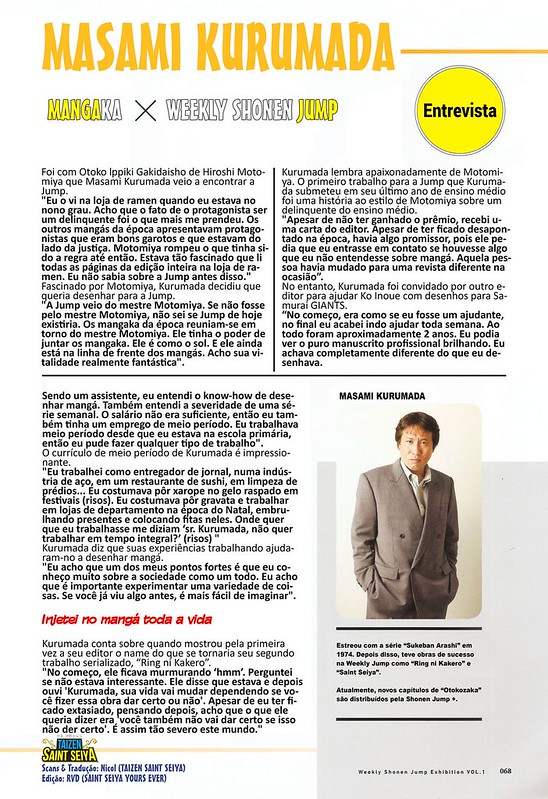
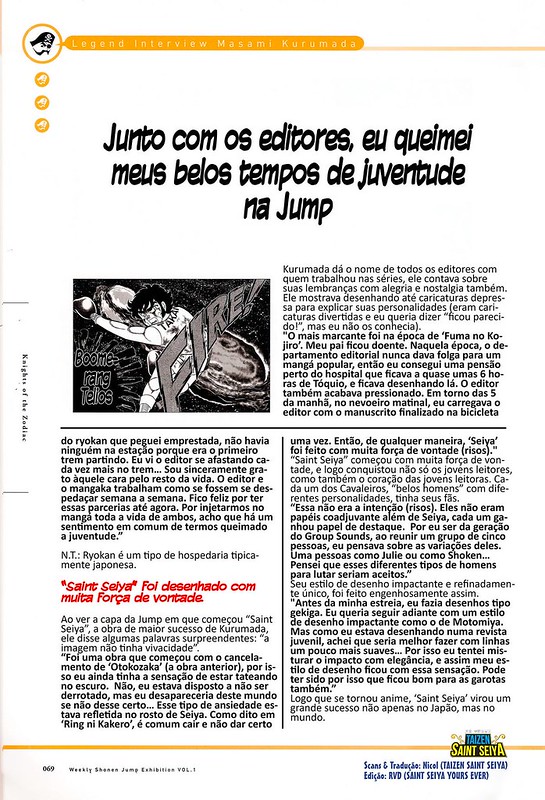
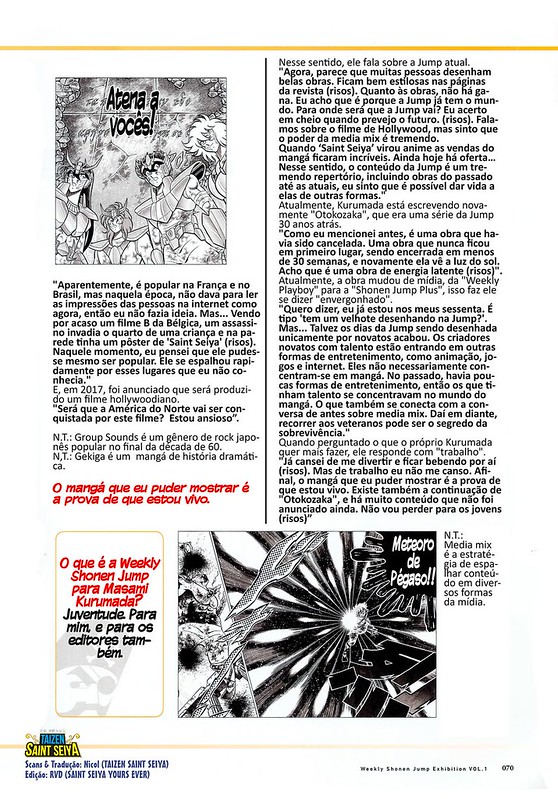

Comentários